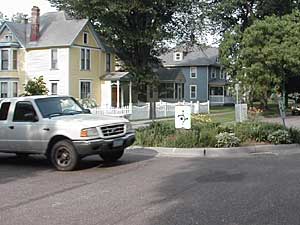June 19, 2005
 |
| St. Paul residents convinced city officials to install a traffic circle to slow vehicles through their neighborhood (MPR photo/Dan Olson) |
St. Paul, Minn. — Every day during rush hour traffic stacks up at the busy St. Paul intersection near where Alice Tibbetts lives. Impatient drivers try save a few seconds by turning off the busy arteries onto the residential street in front of her house.
"I don't think any of us have a problem with people driving down this street, but they were driving as though they were on a freeway," she says.
A couple of years ago Tibbetts and her neighbors convinced the city of St. Paul to spend $5,000 on a traffic circle. It took months and tested their patience but neighbors worked with St. Paul officials to get approval for the idea.
The round concrete structure sits in the middle of the intersection near her home. She says the flower-filled circle has helped trim five miles per hour off the vehicle speeds through the area.
"The green space and the color with the garden in the traffic circle, it gives people a different cue as they come through here," she says.
Some other folks are less patient and occassionally take matters into their own hands, according to Ramsey County traffic engineer Dan Soler.
"We've had folks that have put rocks out in the street to get them to slow down. We've had people make their own flashers and just did their own thing so they can get people to slow down or be more cautious," he said
Soler says in the 20 years he's been on the job, congestion has increased and driver behavior has worsened. The result is more vigilante action by neighborhood residents.
Soler is in a tight spot. Residents clamor for narrower, slower routes. Drivers want wider, faster roads. In the old days counties tended to side with drivers and build four-lane wide streets to move traffic.
The compromise, Soler says, is a generation of newer roads that try to anticipate driver impatience by reducing delays.
"We had turn lanes everywhere for left turns so we didn't have any locations along the route where someone had to take a left turn from a through lane with the potential of a rear end accident," he says.
But turn lanes, roads with shoulders for cyclists and sidewalks for pedestrians aren't enough for some residents. They're lobbying county and city traffic engineers to do more to slow drivers speeding through neighborhoods. Consulting traffic engineer Howard Preston who works in Eagan says a handful of visual changes in the roadway seem to help bring down traffic speeds.
"(Communities are) extending curbs out into the roadways in intersections, doing things with vertical elements with humps and bumps and raising crosswalks and things like that to address some speeds," he says.
Preston is working with residents and city officials in Blaine to map a plan for traffic calming. His binder contains plans already adopted by half a dozen other Twin Cities suburbs.
The problem, Preston says, is people pin the blame on everyone else.
He declines to name the suburb where residents recently raised a ruckus over speeding drivers. They insisted the offenders were drivers from the neighboring suburb until Preston presented them with survey results showing who was cutting through their streets.
"Ninety-six percent of the traffic lived in the neighborhood. Ninety-six," he says.
Howard Preston's survey results are similar to studies from other areas. Residents, not outsiders, account for a high volume of traffic driving through neighborhoods.
Traffic surveys reveal another facet of driver behavior that contributes to the roadway congestion which sparks neighborhood protest. Russ Stark, director of St. Paul's Midway Traffic Management Organization says a surprising number of vehicles on the road are being driven by people making very short trips to the neighborhood store or mall.
"A lot of people are driving that 1/2 mile to a mile to get there. Part of that is the culture and part of that is the design of the place as well," he says.
Stark works with traffic engineers and residents on traffic calming ideas and on alternatives to using the car for short trips.








